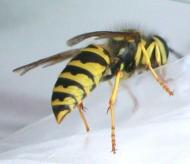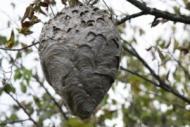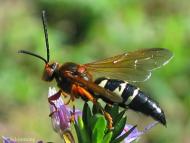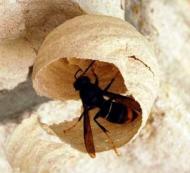Don't Kill The Bees, Please! What to tell kids about bees
by Patricia Robcke
National Pollinator Week is the third week in June--in 2014, it's June 16-23. It's a great excuse to celebrate bees! But usually, instead of introducing kids to bees enthusiastically, we flinch. Are you or your kids afraid of bees? I have a solution for you: Information.
How can families and bees be friends? Here's what you need to know.
Without bees, the world would really be in trouble! Bees pollinate 70 different types of the 100 crop species that make up most of the world’s food. In fact, the world may already have a problem. Honey bees have been dying out inexplicably in some regions. They have been leaving their beehives in the winter when they should be hibernating and dying in the cold. Scientists hypothesize that this is happening in part because people are afraid of bees and often spray dangerous chemicals to kill hem.
Are you afraid of bees? It's important to know that most bees will not sting you unless you swat at them or threaten them first. Still, there are indeed some bees that are more aggressive and could leave you with a nasty sting. So you want to be able to tell the difference.
My kids and I remember it this way:
- Fuzzy bees are fun to look at, but don’t touch.
- Shiny bees can surely sting so stay away.
Fuzzy bees: Fun to watch. Shiny bees: Stay away. Remember too that size does not matter. Large bees can be very social and some small wasps can swarm and be very mean.
The best thing to do is learn where bees nest and avoid disturbing them. Some safety tips:
- Always wear shoes when playing in the grasss
- Don’t kick old logs or rotten fruits and vegetables laying on the ground
- Never throw rocks or sticks at large hives hanging from tree branches
- Don’t poke sticks or fingers into holes in wood structures or trees
- Never try to catch a bee or keep one captive
- If a bee flies close to you, just stay still till it passes. Once it knows you are not a flower it will move along.
Parents, if you suspect there is a nest of stinging bees or wasps nearby, look into safe ways to remove the nests without using pesticides. Pesticides are also a common killer of hummingbirds, which aren’t much bigger than some large bees. So if you like the birds, don’t spray the bees. There are many great websites for safe solutions to problem insects and for more information about bees.
 |
Honey bees are very important to protect. They are fuzzy and usually very small. They are often so busy pollinating that if you don’t bother them they won’t bother you. |
 |
Yellow Jacket Wasps can sting if threatened. Beware when you see these and do not swat at them. Their job is to get rid of trash. They eat garbage, rotten fruits and veggies and can climb into unattended soda cans. They often nest in the ground. So wear shoes, avoid outdoor garbage cans full of food, and use bottles or cups when picnicking. |
 |
Hornets nests are often found hanging from tree branches. Never throw rocks at a nest. It is not a piñata so don’t hit it with sticks. Hornets will swarm and sting repeatedly if their nest is threatened. |
 |
Cicada Bees are known as gentle giants. We have had a family of two to four living in our patio for years. They are curious and will buzz all around you to check you out if you get near their nest. They are huge bees, but won’t hurt you so please don’t hurt them. You may even see them carrying cicada bugs back to their nest. Notice their pretty stripes. |
 |
Brown wasps love boats and docks. You can often find their little paper nests tucked up under ledges, in sails, near water and along the eaves of houses. They don’t seem to be aggressive, but can give a nasty sting if threatened. They are protective over their nests so don’t try to remove the nest unless it’s winter, when they leave their nests. |
 |
If a shrub appears to be moving, it could be full of busy bees. Take a moment to stop and watch them from a safe distance. Busy bees don’t want to be bothered and won’t bother you if you leave them alone. This is when they are doing their jobs, so let them do it.. |
What if someone gets stung?
Last, here are some helpful tips just in case your child is stung by a bee. Most people are stung at least once in their lives. It isn't fun, but it usually isn't devastating, either.
- First, it might seem obvious to say this, but don't panic. The most important thing you can do for your child is stay calm. Smile if you can.
- Use mud or ice to ease the pain, Sting-Kill swabs work great.
- Watch closely for swelling and redness
- Use Benadryl for minor reactions.
- If you suspect an allergic reaction beyond minor pain and redness, call a doctor immediately.
It is very uncommon for one or two bee stings to kill a person, but if you see any of the following severe symptoms, call 911:
- Hives or welts
- Swelling of the face, throat or tongue
- Tingling or funny taste in the mouth
- Dizziness, trouble breathing or fainting
- Rapid heart rate.
One kid-oriented website for treating bee stings is: http://kidshealth.org/parent/firstaid_safe/emergencies/insect_bite.html
Another good site is: http://www.webmd.com/first-aid/allergy-insect-sting-treatment
But let's end on a positive note!
We have adopted a small family of very large cicada bees over the years. Usually flying in twos, they patrol our patio like a pair of watch dogs, checking out visitors when they arrive. Our friends have gotten used to them now, too. When the family gathers on the patio for barbecues, sunsets, and quality time, the bees join us. Also, since we have learned to keep calm and respect the bees, we have enjoyed watching all different varieties of them without any more stings. When we see a new species, we look them up on the internet, then watch and learn.
© 2014, Patricia Robcke
Patricia Robcke lives and works in the North Westchester/Putnam area of New York State. A mother of four teenagers, Patty is a freelance writer and an Executive Board Member of the Town of Cortlandt Green Team.

